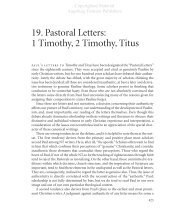Chapter 1 - Augsburg Fortress
Chapter 1 - Augsburg Fortress
Chapter 1 - Augsburg Fortress
Create successful ePaper yourself
Turn your PDF publications into a flip-book with our unique Google optimized e-Paper software.
30 | Eros and the Christ<br />
11. Julian, Ep. 67.<br />
12. Julian, Ep. 16. Cf. Procopius, Ep. 148. See Gustav Karlsson, Idéologie et cérémonial dans<br />
l’épistolographie byzantine: Textes du Xe siècle analysés et commentés, Acta Universitatis Upsaliensis,<br />
Studia Graeca Upsaliensia 3 (Uppsala; Almqvist & Wiksell, 1959), 94–96.<br />
13. Greek Anthology, 9.401. Cf. Synesius, Ep. 138. See Karlsson, Idéologie et cérémonial,<br />
24–33, 51–66.<br />
14. Ovid, Tristia 5.4.23-30. See Thraede, Grundzüge griechisch-römischer Brieftopik, 47–52.<br />
15. Synesius, Ep. 138.<br />
16. Stanley K. Stowers, Letter Writing in Greco-Roman Antiquity, LEC 5 (Philadelphia:<br />
Westminster, 1986), 60.<br />
17. Stanley K. Stowers, “Friends and Enemies in the Politics of Heaven: Reading Theology<br />
in Philippians,” in Pauline Theology, vol. 1: Thessalonians, Philippians, Galatians, Philemon, ed.<br />
Jouette M. Bassler (Minneapolis: <strong>Fortress</strong> Press, 1991), 109.<br />
18. Loveday Alexander (“Hellenistic Letter-Forms and the Structure of Philippians,” JSNT<br />
37 [1989]: 93) offers a compatible characterization of Philippians as a "Verbindungsbrief" (a term<br />
she finds in Koskenniemi, Studien zur Idee und Phraseologie , 107), in which the “exchange of news<br />
and reassurance . . . is initially, at least, the letter's real business.”<br />
19. L. Michael White, “Morality between Two Worlds: A Paradigm of Friendship in<br />
Philippians,” in Greeks, Romans, and Christians: Essays in Honor of Abraham J. Malherbe, ed. David L.<br />
Balch, Everett Ferguson, and Wayne A. Meeks (Minneapolis: <strong>Fortress</strong> Press, 1990), 201–15; John<br />
T. Fitzgerald, “Philippians in the Light of Some Ancient Discussions of Friendship,” in idem,<br />
Friendship, Flattery, and Frankness of Speech, 141–60; and, in the same volume, Ken Berry, “The<br />
Function of Friendship Language in Philippians 4:10-20,” 107–24; and Abraham J. Malherbe,<br />
“Paul's Self-Sufficiency (Philippians 4:11),” 125–39.<br />
20. σφοδρός: John Chrysostom, Epp. 50, 55, 56, 80, 82, 172, 175, 223, 225. θερμός: Ep.<br />
218. Cf. Procopius, Ep. 26; Dionysius, Ep. 1.<br />
21. John Chrysostom, Epp. 164, 218. See Karlsson, Idéologie et cérémonial, 62–78.<br />
22. John Chrysostom, Epp. 22, 96, 222, 223.<br />
23. What holds Basil back from enthusiastic agreement with the theory he articulated so<br />
well? Perhaps he is aware of the danger that amplification of friendship by erōs posed. For the<br />
intricacies of accommodating erōs to Christian friendship, see Jostein Børtnes, "Eros Transformed:<br />
Same-Sex Love and Divine Desire," in Greek Biography and Panegyric in Late Antiquity, ed. Tomas<br />
Hägg and Philip Rousseau, Transformation of the Classical Heritage 31 (Berkeley: University of<br />
California Press, 2000), 180–93.<br />
24. Basil, Ep. 124. It is noteworthy that Basil goes on to say that the letter carrier is the<br />
image of the sender. Confusion of letter and letter carrier in re-presenting the writer was not<br />
uncommon and deserves further study.<br />
25. Basil knew this; see, for example, Ep. 342: “nature has caused those delicate thorns to<br />
grow upon this flower that they might serve, as do the sundry ticklings which lovers use, to incite<br />
gently to a greater desire (μείζονα πόθον) by their pleasant prickings of their stings (εὐπλήκτοις<br />
κέντροις).”<br />
26. See Anna De Pretis, “‘Insincerity,’ ‘Facts,’ and ‘Epistolarity’: Approaches to Pliny's<br />
Epistles to Calpurnia,” Arethusa 36 (2003): 127–46.<br />
27. Julian, Ep. 77. See also Ep. 78: “And when I received it I kissed it and held it to my eyes<br />
and kept tight hold of it as though I were afraid that while I was in the act of reading your letter<br />
the phantom of your image might elude me and fly away.” See Theodoros of Kyzikos, Ep. 2.<br />
28. Chariton, Chaer. 8.5.13. Translation is from Collected Ancient Greek Novels, ed. B. P.<br />
Reardon (Berkeley: University of California Press, 1989), 119. Braulio of Saragossa (590–651) was<br />
encouraged by his bishop, Isidore of Seville, to receive letters from friends in a physical way:<br />
“When you receive a letter of a friend, dearest son, you should not delay to embrace it as a friend.<br />
For it is a fine consolation among the absent that if one who is loved is not present, a letter may be




